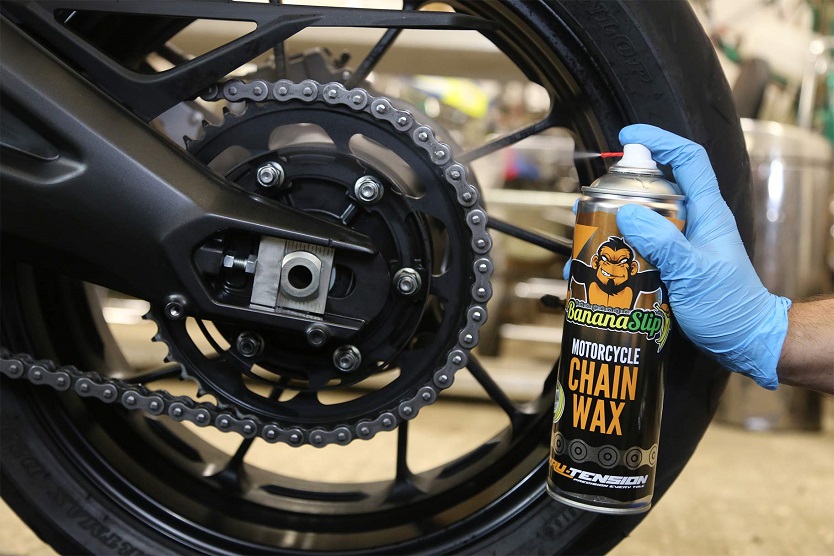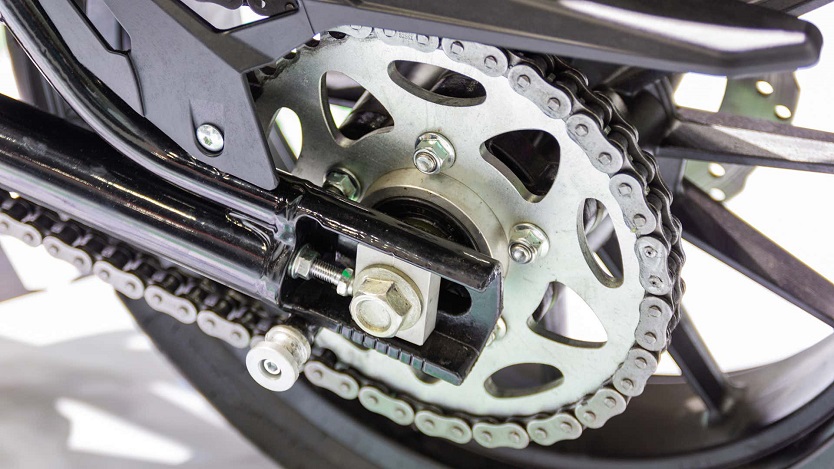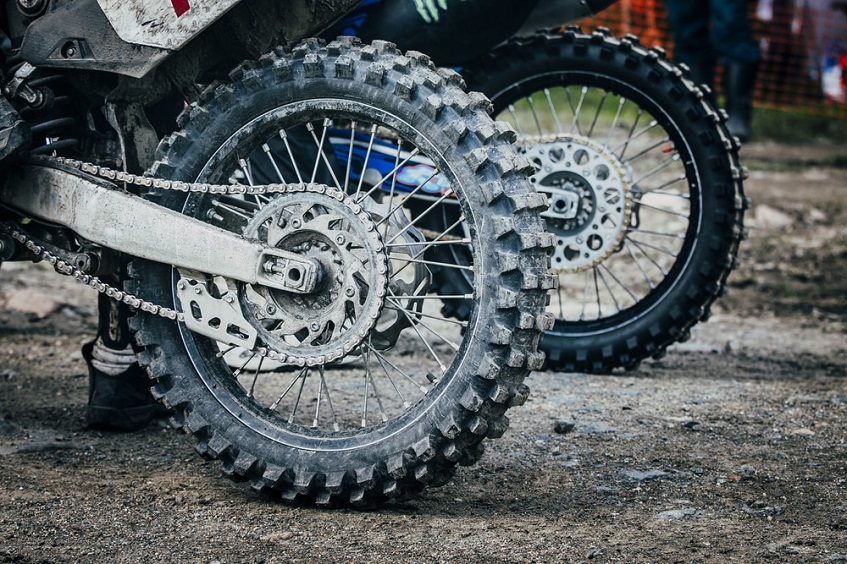
Motorcycle Parts 101: Get All the Info on Motorcycle Chains
Unless you’ve experienced a drive chain problem in the past, it’s easy to overlook just how important it is to take care of one. And that’s unfortunate, because aside from your tyres, your chain is one of the crucial moto parts that deserves attention.
A chain conveys engine power to the rear wheel via 120 interconnected links that pivot on cylindrical sleeves called rollers. And although most chain wear is limited to where the rollers make contact with the gearbox and wheel sprockets, every component in the chain is subjected to the unavoidable mechanical and environmental stresses that keep the bike moving.
Drive chains do more than just deliver power to the rear wheel, though. They also absorb driveline shock loads that are generated under hard acceleration and severe engine braking which, if not passively dampened, can quickly ruin your gearbox’s bearings and seals. In short, the chain is possibly the hardest working component on your bike, and you don’t want to put off inspecting it or replacing it when necessary.
Contents
High Quality Drive Chains

Make no mistake: there are a lot of factors that can affect the condition of your chain. Everything from rust buildup, to how aggressively you ride can shorten its lifespan. That’s why they have to be inspected regularly; and when it’s time to replace them, you only want to use high quality motorcycle chains and driveline parts that are made especially for your bike. You also need to have the best selection of chain maintenance tools to perform the most thorough inspections.
The consequences for not inspecting and maintaining your motorcycle chain in a timely manner are too great to ignore, and any of the following conditions can lead to a chain becoming overstressed or even breaking:
· Lack of lubrication;
· Improper tension or alignment; and,
· Excess dirt and grime buildup.
Making sure that your chain is clean, adjusted, and properly lubricated at all times is going to help keep it serviceable, but when the time inevitably comes to replace it, you can’t afford to drag your feet about getting it done. There are lots of aftermarket chain types and manufacturers on the market though, and knowing a little bit about the main differences between them is going to make finding the right replacement easier.
Sealed and Unsealed Drive Chain
At their most basic, every motorcycle drive chain is the same. They’re high-speed assemblies designed to withstand extreme amounts of heat, stress, and exposure to rain and dirt. The conditions they’re intended to function best under, however, depend on whether they have seals or not.
There are two basic types of drive chains: sealed and unsealed. Sealed chains have rubber seal rings between their inner and outer link plates to seal out dirt and residue, as well as to seal in vital lubrication. Unsealed chains don’t have these rings, giving them a slim benefit in cost and weight, but not in wear or maintenance.
Sealed chains typically require less frequent lubrication than their unsealed counterparts, but they’re also further divided between O-ring and X-ring seal types. O-type rings compress to create a single, large sealing surface between their link plates, while X-type rings compress to create two smaller sealing surfaces that create less friction.
It’s important to keep in mind how much of a role seals and lubrication play in chain construction. Lubrication disburses heat, and heat is the single greatest contributor to chain fatigue and breakage. By performing regular inspections and paying careful attention to how your bike feels, you’ll be able to detect the early signs of chain wear, such as:
· Unusual noise or vibration under acceleration;
· Poor or problematic acceleration or performance;
· Excess slack or float in the chain;
· Visible signs of sprocket wear; and,
· Visible signs of chain wear, including damaged or missing seals.
In short, if you’re experiencing or noticing any of these signs, your drive chain needs replacing. And along with whether your chain has seals or not, there are two other equally crucial identifying traits: pitch and width. Together, all these characteristics tell you everything you need to know about your chain’s specifications. Once you’re familiar with them, deciding which chain is the right one for your bike is going to be a lot easier.
Chain Pitch and Width

The sizes for all motorcycle chains for sale are determined by their pitch and width.
· Pitch. This is the distance between the centre points of any two roller pins forming a link.
· Width. This is the distance between the inside faces of any two inner plates forming a link.
These dimensions are expressed by a standardized range of three-digit chain sizes, with the first digit corresponding to the pitch of the chain, and the last two corresponding to the chain’s width. In almost every circumstance they’ll be classified as follows:
Chain size Pitch Width
415 1/2” 3/16”
420 1/2” 1/4”
428 1/2” 5/16”
520 5/8” 1/4”
525 5/8” 5/16”
530 5/8” 3/8”
630 3/4” 3/8”
To minimize confusion when replacing chains, manufacturers typically stamp the chain size directly onto each chain. However, if the size has been worn off, or if you’re uncertain about whether it has the right chain on it, you don’t want to take any chances by guessing the size or using a calliper to measure a stretched chain. In either of these cases, it’s best to verify the correct size with your bike’s manufacturer. As a rule of thumb, you’ll typically find drive chains installed as such:
· 415, 420, and 428 chains. Used on scooters, dirt bikes, and ATVs.
· 520 chains. Used on dirt and dual sports bikes, and ATVs.
· 525 chains. Used on street bikes.
· 520 chains. Used on high performance street and hyper bikes.
· 630 chains. Used on drag bikes and heavy cruisers.
The Reasons for Taking Care of Your Chain
Having a comprehensive grasp on all the measurements and details behind motorbike chain specifications can seem daunting, but it all comes down to this: your chain needs to be regularly adjusted, cleaned, and lubricated to properly do what it’s designed to do, and replaced when it can no longer do it. And as easy as it is to forget to do these things, the risk of not doing them opens up the possibility for your chain to:
· Come off the bike and leave you with no power at a critical moment;
· Get forcefully hurled into another vehicle;
· Become entangled in the rear sprocket and lock the rear wheel;
· Cause irreparable damage the bike’s crankcase; or,
· Seriously injury you, your passenger, or a pedestrian.
You simply don’t want to take these kinds of unnecessary risks with your bike, and buying a new chain at the appropriate time is going to help you avoid them.
The Final Word
At the end of the day, maintaining the chain on your bike is just as important as checking your brakes and tyres. With a schedule of regular maintenance using a quality selection of chain brushes, and lubrication and slacksetting tools, a well-serviced chain can last for years. Eventually though, it’s going to have to be replaced, and investing in the highest quality motorcycle chains is going to be one of the best decisions you can make toward keeping your bike safe and running.
And remember, it’s a good idea to also replace your front and rear sprockets at the same time you replace your drive chain. It ensures your complete driveline is in top running order for braking as well as acceleration. And that’s the peace of mind you want every time you ride.


No Comments